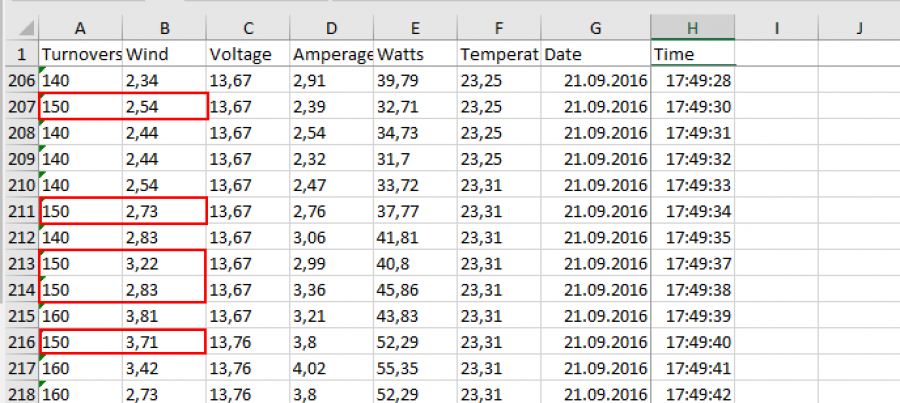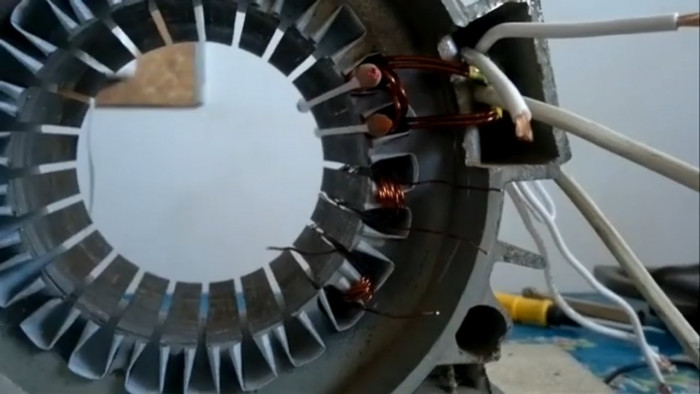
One of the key indicators of the operation of the wind turbine is the wind energy utilization rate. This indicator depends both on the aerodynamic and geometric indices of the wind turbine. The task of the theoretical calculation of the wind turbine is to accurately calculate the aerodynamic characteristics of the wind turbine wheels, and to optimize their geometry to obtain a set power index.
The proposed mathematical model allows implementing such an optimization with a high accuracy in a few seconds. Therefore, a decision was taken to verify the algorithm of the work of the "Aerodinama" software system by making the physical model of the wind turbine, and checking it in real conditions of operation.
To monitor the performance of the wind turbine, a logger was developed based on the Arduino Nano microcontroller version 3.0 and a set of multiple sensors, namely, the HOLA KY-003 Hall sensor, the ACS712 30A sensor and the DS18B20 sensor. The wind speed was measured using an analog anemometer with an electromagnetic system, and controlled by the voltage level at the outlet. The current data was stored on the memory card and duplicated on the display. The measurement step was 1 sec. The following indices were monitored: wind speed, velocity of the working shaft of the winder, voltage at the output of the rectifier unit, current at the rectifier output, power and temperature of the windings of the generator.
In order to verify the mathematical model, a wind turbine with a generator on permanent neodymium magnets with a power of 400 W and a starting torque of 0.49 N·m was used. The efficiency of the generator was 80%. For the wind wheel, a trilateral propeller with a profile of blades BRUXEL 36 was selected. The average annual wind speed was taken as 3.5 m/s, and the boisterous speed as 25 m/s.
As the result of the calculations, a windrow with a diameter of 2.55 m was obtained, the wind power factor being 0.46 and the estimated circulation of 340 rpm. The starting wind speed was 1.5 m/s, the design force of the frontal pressure was taken as 170 N and the calculated torque on the generator shaft was 11.2 Nm.
From the set of cloud points obtained as the result of mathematical modeling, a 3D model of the wind wheel was constructed using SolidWorks software package, then its physical model was casted and the VEU was developed.
In the framework of protection of wind turbines from adverse conditions, mechanical protection was used, which ensured the output of the windrow from the working plane to the plane of the parallel wind direction. The protection was set in such a way that it started to operate at the speed of about 8 m/s. The work of the electric generator was aimed at charging the batteries through the charger.
The collected data were imported into the MS EXCEL software package for processing and plotting charts. In fig. 1, we can see the fragment of the file with the data.
The example clearly demonstrates that the values of the wind speed and the wind wheel speed do not have a clear and direct relationship. For example, we can see that the values of 150 rpm in lines 207, 211, 213 and 214 correspond to different wind speeds, namely 2.54, 2.73, 3.22 and 2.83. Such a difference in the rates is due to the inertia of the mechanical system of the wind turbine and the effect of electric loading.

The insignificant nature of the variation of indicators makes it possible to construct graphs of the dependence of the wind speed and the wind wheel speed in a sufficiently large range.
As in the construction of graphs of the calculation model the power was given as a mechanical parameter and for logging the data this parameter was electric, to compare the results we only selected the graph of the dependence of the wind wheel turn on the wind speed. In the MS EXCEL software system, the graph 2 was constructed.

Insignificant non-linearity of the graph on the left occurs due to the influence of the battery charge control system as the result of the electric load on the generator, which in turn gives an additional load on the wind wheel. Nevertheless, using the graphs it is possible to trace clearly that the received data correspond to the calculated ones.
The experiment carried out with the help of the power plant of 400 W, confirmed the correctness of the mathematical model obtained using the software system "Aerodinama". Minor deviations of the mathematical model from the physical one exist due to the lack of consideration of the additional parameters affecting the work of the CE. The consumer's influence on electric energy can be included into these parameters.
 Serhii Korneliuk
Serhii Korneliuk


